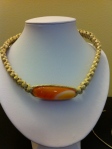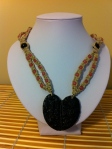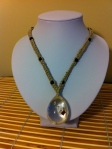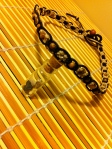handmade jewelry April 20, 2011
here are some necklaces and bracelets that i made recently, to see everything i have go to http://www.facebook.com/papayasunrise. soon ill have things organized and together, it may take me a few weeks! haha!
hemp vs. cotton
Hemp production is easy to achieve organically. Therefore many of the ecological problems in chemical farming of other fibres are obviated. Hemp quickly grows up to 5 metres in height with dense foliage which blocks weed growth. This means herbicides are not needed and the field is weed free for the next crop. Unlike cotton hemp does not have a high water requirement. The hemp plant has a deep tap root system which enables the plant ot take advantage of deep subsoil moisture, thus requiring little or no irrigation.
Hemp has been produced for thousands of years as a source of fibre for paper, cloth, sails/canvas and building materials. Natural fibre from the hemp stalk is extremely durable and can be used in the production of textiles, clothing, canvas, rope, cordage, archival grade paper, paper, and construction materials.
There are two principal types of fibres in hemp – bast or long fibres and hurds or inner short fibre. Traditionally hemp has been grown for its valuable and versatile high quality bast fibres. Bast fibres account for 20-30 percent of the stalk (depending on the seed variety, and planting density). There are two types of bast fibres:
· primary bast fibres. Primary bast fibres make up approximately 70 percent of the fibres and are long, high in cellulose and low in lignin. Primary bast fibres are the most valuable part of the stalk, and are generally considered to be among the strongest plant fibres known.
· secondary bast fibres. Secondary bast fibres make up the remaining 30 percent of the bast fibres and are medium in length and higher in lignin. They are less valuable and become more prevalent when the hemp plants are grown less densely, making shorter fatter stalks since they do not have to compete for light.
The production or extraction of the primary bast fibres has traditionally been a very labour intensive process, but recently an alternative fibre separation process has been developed using technologies such as ultrasound and steam explosion, which are much less labour intensive. Once separated the bast fibres are ready for spinning and weaving into textiles, or for pulping into high quality pulp. Bast fibres are ideal for specialised paper products such as industrial filters, currency paper, tea bags or cigarette paper.
Hurds are the short fibred inner woody core of the hemp plant. They comprise 70-80 percent of the stalk and are composed of libriform fibres which are high in lignin. Traditionally hurds have been considered waste as they are the by-product from bast extraction. The hurds are 50-77 pecent cellulose making them ideal for paper making. One acre of hemp can replace 4.1 acres of trees for pulp production. Although the fibres are shorter than bast fibres they are suitable for a range of products such as rayon, biomass fuel, cellophane, food additives, industrial fabrication materials and newsprint pulp.
Hemp as Clothing and Textiles
China is currently the prime producer of hemp textile. China has had an uninterrupted hemp trade for approximately 6000 years. Other countries are now producing hemp textiles to a lesser extent. The once major hemp textile industry has now almost completely disappeared from the Western world. Currently the bulk of our demand for textiles is met by cotton and synthetics, both of which have serious environmental problems associated with them.
Not only are there environmental benefits to be gained through hemp cultivation, hemp fabrics themselves have advantages to us. Organic clothing and fabrics have no residual chemicals to impact our health. Fabrics with at least 50 percent hemp content block the sun’s UV rays more effectively than do other fabrics. In comparison to cotton, hemp fibres are longer, stronger, morelustrous and absorbent, and more mildew resistant.
Hemp textiles are extremely versatile – they are used in the production of clothing, shoes, apparel, canvas, rugs and upholstery.
Is hemp more ecologically friendly than cotton?
Anything that can be made from cotton can be made from hemp. Hemp’s long fibres give it the strength to create a finished product that is much stronger and more durable than one produced from cotton. Just as hemp can be cultivated instead of trees, it can also be grown in place of cotton, with environmental benefits.
Cotton is one of the most environmentally destructive agricultural crops. In pesticide use in the US alone, is staggering – 125 million kilograms annually. Worldwide, cotton production used 50 percent of the world’s pesticides/herbicides. Pesticides are possibly the greatest toxic threat to contaminating our soil, air, water and natural communities because they are often permanent and they bio-accumulate, ie their toxicity increases as they are consumed up the food chain. Many pesticides are known carcinogens, and can also cause immuno-deficiency disorders. Added to this, pesticides have a petroleum base and their excessive use perpetuates our dependency on oil.
Cotton also requires large quantities of fertilisers, growth regulators, general biocides such as methyl bromide, and water. Hemp on the other hand, is one of the most environmentally positive crops that actually leaves the soil enriched. Hemp requires little or no pesticides or herbicides and the extensive and deep root system draws nutrients from deeper soil layers, and when the roots breakdown after harvest they aerate the soil and provide humus. Hemp grows very tall and thick, shading and mulching the ground contributing to a healthy microbial life in the soil.
Cotton grows only in moderate climates and requires more water than hemp. Hemp grows in a wide range of climates and is frost tolerant. Hemp requires only moderate amounts of water whereas cotton requires large amounts of water.
Hemp fibre bundles are up to fifteen feet long while cotton fibres are less than an inch. Hemp has eight times the tensile strength and four times the durability of cotton. Hemp is more absorbent than cotton and therefore takes dyes better.
On an annual basis, 1 acre of hemp will produce as much fibre as 2-3 acres of cotton. Two and a half acres (one hectare) of hemp produces approximately 8000-11000 kilograms of dry biomass. Hemp fibre comes right off the plant ready to comb and use. Hemp fibre lasts longer, is softer than cotton, and will not mildew (hemp has been used for sails for thousands of years for this reason).
Building Materials
Processing Hemp Stalks
Hemp bast or long fibre and hurds or inner short fibre can be processed and used with existing technology in construction. The hemp stalk can be incorporated into building materials straight from the field. Hemp fibre added to concrete increases tensile and compressive strengths, reduces shrinkage and cracking.
The demand for renewable raw materials is increasing. Currently many companies produce non-woven products like mats for insulation and car/vehicle composites based mainly on flax but increasingly now on hemp fibres. Hemp fibres have excellent potential – they can reinforce plastics, substitute mineral fibres, be recycled, can be grown ecologically, and have no waste disposal problems. A range of products can be derived from non-woven mats for a range of uses: insulation, filters, geotextile, growth media, reinforced plastics and composites.
Natural fibre composites (NFCs)are formulated from a blend of natural fibres such as kenaf, hemp, flax, jute and sisal, and thermoplastic polymers. NFCs are approximately 25 percent stronger than wood fibre reinforced thermoplastics and have none of the negative handling or environmental issues associated with glass fibre.
Hemp Concrete & Insulation
Hemp hurds are not only very absorbent, but are also uncommonly rich in silica. When mixed with lime, hemp hurds change from a vegetable product to a mineral. In this mineral state it is often referred to as hemp stone, and it weighs between 1/5 and 1/7 that of cement based concrete. Several hundred houses have been built in Europe using this material. Research is ongoing in the UK and Germany, where hemp hurds have been used for the construction of floors since the mid 1900s. Sometimes the hemp hurds are mixed with lime, water and either gypsum or river sand. When it is poured it hardens, and becomes mould and insect resistant. It can be used in drywall construction between formwork, as an interior and exterior insulation or be poured as a floor. The formwork can be removed within a couple of hours.
One advantage of hemp concrete is that it makes it unnecessary to have several layers of conventional building materials – it is outer and inner wall, and insulation all in one – it can replace bricks or cement-concrete, a vapour barrier, insulation, and plaster board or panelling. All that is needed as a finish is an exterior coat of whitewash to which pigments can be added if desired. The interior surface is an attractive cork-like texture that can be waxed or varnished (using a hemp based varnish).
One of the most popular hemp concrete products is Isochanvre, a French product. The manufacturers claim:
- excellent acoustic insulation
- breathes, prevents condensation
- self-draining and waterproof
- non-flammable (no toxic combustion products)
- resistant to rodents, termites, insects, fungi and bacteria (because of the silica content)
- easy to use, flexible and crack-resistant
- ideal for cyclone and earthquake prone areas due to its strength/weight ratio
- lightness
- able to use fewer finishing such as no plaster, painting or wallpaper.
With all this in mind, hemp can be viewed as an exceptional building material, whether we use ecological, architectural, practical or end-user criteria. Ecologically, using hemp hurds as concrete and insulation, makes sense. From a ‘life-cycle analysis’ perspective hemp construction materials win hands down. From its origins as an annual crop, hemp supports agriculture, it provides an alternative to timber/tree use and therefore tree clearing, does away with the need for mining, and requires no chemical processing in the defibration or stabilisation stages. Because of the simple, natural materials used, there is no air or water pollution, no waste is produced since all parts of the plant are used, and only minimal energy is required for processing. From the human perspective, it is easy and safe to work with since it is lime based, and it doesn’t require maintenance. The petrification process continues resulting in a stronger, better material with age. Like all hemp products, it is biodegradable.
























